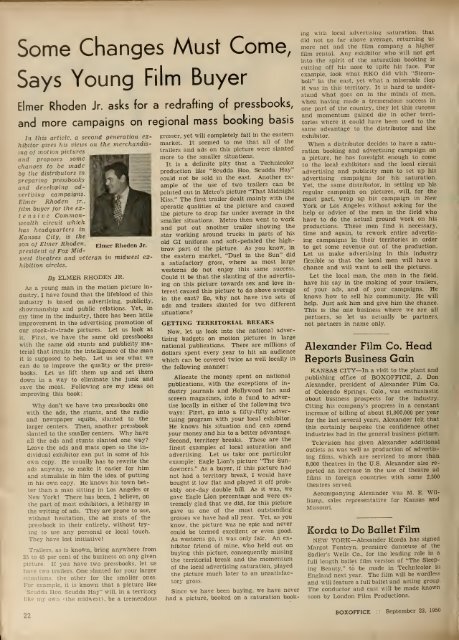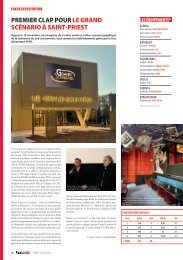Boxoffice-September.23.1950
Create successful ePaper yourself
Turn your PDF publications into a flip-book with our unique Google optimized e-Paper software.
Some Changes Must Come,<br />
Says Young Film<br />
Buyer<br />
Elmer Rhoden Jr. asks for a redrafting of pressbooks,<br />
and more campaigns on regional mass booking basis<br />
In this article, a second generation exhibitor<br />
gives his vieivs on the merchandising<br />
of motion pictures<br />
and proposes some<br />
changes to be made<br />
by the distributors in<br />
preparing pressbooks<br />
and developing advertising<br />
campaigns.<br />
Elmer RJioden jr..<br />
film buyer for the extensive<br />
Commonwealth<br />
circuit which<br />
has headquarters in<br />
Kansas City, is the<br />
son of Elmer Rhoden. Elmer Rhoden Jr.<br />
president of Fox Midwest<br />
theatres and veteran in midwest exhibition<br />
circles.<br />
By ELMER RHODEN JR.<br />
As a young man in the motion picture Industry,<br />
I have found that the lifeblood of this<br />
industry is based on advertising, publicity,<br />
showmanship and public relations. Yet, in<br />
my time in the industry, there has been little<br />
improvement in the advertising promotion of<br />
our stock-in-trade pictures. Let us look at<br />
it. First, we have the same old pressbooks<br />
with the same old stunts and publicity material<br />
that insults the intelligence of the man<br />
it is supposed to help. Let us see what we<br />
can do to improve the quality or the pressbooks.<br />
Let us lift them up and set them<br />
down in a way to eliminate the junk and<br />
save the meat. Following are my ideas on<br />
improving this book:<br />
Why don't we have two pressbooks one<br />
with the ads, the stunts, and the radio<br />
and newspaper squibs, slanted to the<br />
larger centers. Then, another pressbook<br />
slanted to the smaller centers. Why have<br />
all the ads and stunts slanted one way?<br />
Leave the ads and mats open so the individual<br />
exhibitor can put in some of his<br />
own copy. He usually has to rewrite the<br />
ads anyway, so make it easier for him<br />
and stimulate in him the idea of putting<br />
in his own copy. He knows his town better<br />
than a man sitting in Los Angeles or<br />
New York! There has been, I believe, on<br />
the part of most exhibitors, a lethargy in<br />
the writing of ads. They are prone to use,<br />
without hesitation, the ad mats of the<br />
pressbook in their entirety, without trying<br />
to use any personal or local touch.<br />
They have lost initiative!<br />
Trailers, as is known, bring anywhere from<br />
35 to 45 per cent of the business on any given<br />
picture. If you have two pressbooks, let us<br />
have two trailers. One slanted for your larger<br />
situations, the other for the smaller ones.<br />
For example, it is known that a picture like<br />
Scudda Hoo, Scudda Hay" will, in a territory<br />
like my own (the midwest), be a tremendous<br />
grosser, yet will completely fail in the eastern<br />
market. It seemed to me that all of the<br />
trailers and ads on this picture were slanted<br />
more to the smaller situations.<br />
It is a definite pity that a Technicolor<br />
production like "Scudda Hoo, Scudda Hay"<br />
could not be .sold in the east. Another example<br />
of the use of two trailers can be<br />
pointed out in Metro's picture "That Midnight<br />
Kiss." The first trailer dealt mainly with the<br />
operatic qualities of the picture and caused<br />
the picture to drop far under average in the<br />
smaller situations. Metro then went to work<br />
and put out another trailer showing the<br />
star working around trucks in parts of his<br />
old GI uniform and soft-pedaled the highbrow<br />
part of the picture. As you know, in<br />
the eastern market, "Duel in the Sun" did<br />
a satisfactory gross, where as most large<br />
westerns do not enjoy this same success.<br />
Could it be that the slanting of the advertising<br />
on this picture towards sex and love interest<br />
caused this picture to do above average<br />
in the east? So, why not have two sets of<br />
ads and trailers slanted for two different<br />
situations?<br />
GETTING TERRITORIAL BREAKS<br />
Now, let us look into the national advertising<br />
budgets on motion pictures in large<br />
national publications. There are millions of<br />
dollars spent every year to hit an audience<br />
which can be covered twice as well locally in<br />
the following manner:<br />
Allocate the money spent on national<br />
publications, with the exceptions of industry<br />
journals and Hollywood fan and<br />
screen magazines, into a fund to advertise<br />
locally in either of the following two<br />
ways: First, go into a fifty-fifty advertising<br />
program with your local exhibitor.<br />
He knows his situation and can spend<br />
your money and his to a better advantage.<br />
Second, territory breaks. These are the<br />
finest examples of local saturation and<br />
advertising. Let us take one particular<br />
example: Eagle Lion's picture "The Sundowners."<br />
As a buyer, if this picture had<br />
not had a territory break, I would have<br />
bought it low flat and played it off probably<br />
one-day double bill. As it was, we<br />
gave Eagle Lion percentage and were extremely<br />
glad that we did, for this picture<br />
gave us one of the most outstanding<br />
grosses we have had all year. Yet, as you<br />
know, the picture was no epic and never<br />
could be termed excellent or even good.<br />
As westerns go. it was only fair. An exhibitor<br />
friend of mine, who held out on<br />
buying this picture, consequently missing<br />
the territorial break and the momentum<br />
of the local advertising saturation, played<br />
the picture much later to an unsatisfactory<br />
gross.<br />
Since we have been buying, we have never<br />
had a picture, booked on a saturation booking<br />
with local advertising saturation, that<br />
did not go far above average, returning us<br />
more net and the film company a higher<br />
film rental. Any exhibitor who will not get<br />
into the spirit of the saturation booking is<br />
cutting off his nose to spite his face. For<br />
example, look what RKO did with "Stromboli"<br />
in the east, yet what a miserable flop<br />
It was in this territory. It is hard to under-<br />
.stand what goes on in the minds of men,<br />
when having made a tremendous success in<br />
one part of the country, they let this success<br />
and momentum gained die in other territories<br />
where it could have been used to the<br />
.same advantage to the distributor and the<br />
exhibitor.<br />
When a distributor decides to have a saturation<br />
booking and advertising campaign on<br />
a picture, he has foresight enough to come<br />
to the local exhibitors and the local circuit<br />
advertising and publicity men to set up his<br />
advertising campaigns for his saturation.<br />
Yet, the same distributor, in setting up his<br />
regular campaign on pictures, will, for the<br />
most part, wrap up his campaign in New<br />
York or Los Angeles without asking for the<br />
help or advice of the men in the field who<br />
have to do the actual ground work on his<br />
productions. These men find it necessary,<br />
time and again, to rework entire advertising<br />
campaigns in their territories in order<br />
to get some revenue out of the production.<br />
Let us make advertising in this industry<br />
flexible so that the local men will have a<br />
chance and will want to sell the pictures.<br />
Let the local man, the man in the field,<br />
have his say in the making of your trailers,<br />
of your ads, and of your campaigns. He<br />
knows how to sell his community. He will<br />
help. Just ask him and give him the chance.<br />
This is the one business where we are all<br />
partners, so let us actually be partners,<br />
not partners in name only.<br />
Alexander Film Co. Head<br />
Reports Business Gain<br />
KANSAS CITY—In a visit to the plant and<br />
publishing office of BOXOFFICE, J. Don<br />
Alexander, president of Alexander Film Co.<br />
of Colorado Springs, Colo., was enthusiastic<br />
about business prospects for the industry.<br />
Citing his company's progress in a constant<br />
increase of billing of about $1,000,000 per year<br />
for the last several years, Alexander felt that<br />
this certainly bespoke the confidence other<br />
industries had in the general business picture.<br />
Television has given Alexander additional<br />
outlets as was well as production of advertising<br />
films, which are serviced to more than<br />
8,000 theatres in the U.S. Alexander also reported<br />
an increase in the use of theatre ad<br />
films in foreign countries with some 2.500<br />
theatres served.<br />
Accompanying Alexander was M. E. Williams,<br />
sales representative for Kansas and<br />
Missouri.<br />
Korda to Do Ballet Film<br />
NEW YORK—Alexander Korda has signed<br />
Margot Fonteyn, premiere danseuse of the<br />
Sadler's Wells Co., for the leading role in a<br />
full length ballet film version of "The Sleeping<br />
Beauty," to be made in Technicolor in<br />
England next year. The film will be wordless<br />
and will feature a full ballet and acting group.<br />
The conductor and cast will be made known<br />
soon by London Film Productions.<br />
22<br />
BOXOFFICE<br />
:: September 23, 1950

















